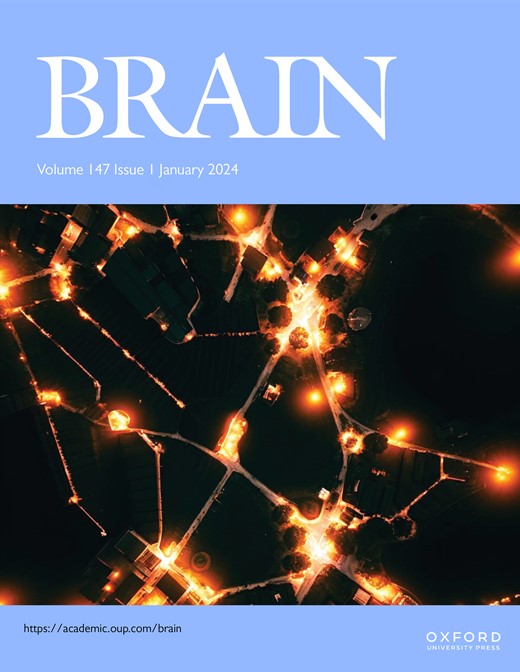PU.1 restores microglial dysfunction caused by C9ORF72 repeat expansions in neural organoids.
IF 11.7
1区 医学
Q1 CLINICAL NEUROLOGY
引用次数: 0
Abstract
Amyotrophic lateral sclerosis (ALS) is an adult-onset neurodegenerative disease characterized by loss of upper and lower motor neurons and progressive muscle wasting. Accumulating evidence indicates a role for non-neuronal cells in ALS pathogenesis, but their exact role and mechanism-of-action remain incompletely understood. A hexanucleotide (GGGGCC) repeat expansion (HRE) in C9ORF72 is the most common genetic cause of ALS (C9-ALS) and a frequent cause of frontotemporal dementia (FTD). Several lines of experimental evidence support a role for the immune system and microglia in C9-ALS/FTD, and, depending on experimental settings and species used, both reduced and increased microglial activity have been reported. To further study microglia in C9-ALS/FTD in the context of a complex, three-dimensional disease environment, we developed cerebral organoids that innately develop microglia derived from induced pluripotent stem cells (iPSCs) of C9-ALS/FTD patients and controls. Here we show reduced cellular complexity and transcriptional changes in C9 neural organoid-derived microglia (C9-oMGs), involving phagocytic, lysosomal and immune response pathways. The release of inflammatory cues from C9-ALS/FTD organoids is decreased and LAMP1 expression in C9-oMGs is reduced. Functional analysis using live imaging reveals impaired phagocytosis by C9-oMGs and reduced engulfment of the post-synaptic protein PSD-95 by C9-oMGs in organoids. Finally, our transcriptomics analysis identifies a PU.1 (encoded by SPI1) regulon as the most strongly downregulated transcription factor network in C9-oMGs. Viral overexpression of PU.1 rescues phagocytosis and gene expression defects in C9-microglia. Overall, our data demonstrate reduced microglial functions in a complex cellular disease environment and identify PU.1 as a potential target for restoring microglia changes in C9-ALS/FTD.PU.1可恢复神经类器官中C9ORF72重复扩增引起的小胶质功能障碍。
肌萎缩性侧索硬化症(ALS)是一种以上下运动神经元丧失和进行性肌肉萎缩为特征的成人神经退行性疾病。越来越多的证据表明非神经元细胞在ALS发病机制中起作用,但它们的确切作用和作用机制仍不完全清楚。C9ORF72中的六核苷酸(GGGGCC)重复扩增(HRE)是ALS (C9-ALS)最常见的遗传原因,也是额颞叶痴呆(FTD)的常见原因。一些实验证据支持免疫系统和小胶质细胞在C9-ALS/FTD中的作用,并且,根据实验设置和使用的物种,小胶质细胞活性降低和增加都有报道。为了在复杂的三维疾病环境中进一步研究C9-ALS/FTD中的小胶质细胞,我们开发了脑类器官,这些器官天生就能从C9-ALS/FTD患者和对照组的诱导多能干细胞(iPSCs)中产生小胶质细胞。本研究显示,C9神经类器官源性小胶质细胞(C9- omgs)的细胞复杂性降低,转录发生变化,涉及吞噬、溶酶体和免疫反应途径。C9-ALS/FTD类器官的炎症信号释放减少,C9-oMGs中的LAMP1表达减少。实时成像功能分析显示,类器官中C9-oMGs的吞噬功能受损,C9-oMGs对突触后蛋白PSD-95的吞噬减少。最后,我们的转录组学分析确定了PU.1(由SPI1编码)调控是C9-oMGs中下调最强烈的转录因子网络。病毒过表达PU.1可挽救c9小胶质细胞的吞噬和基因表达缺陷。总的来说,我们的数据表明在复杂的细胞疾病环境中小胶质细胞功能降低,并确定PU.1是恢复C9-ALS/FTD小胶质细胞变化的潜在靶点。
本文章由计算机程序翻译,如有差异,请以英文原文为准。
求助全文
约1分钟内获得全文
求助全文
来源期刊

Brain
医学-临床神经学
CiteScore
20.30
自引率
4.10%
发文量
458
审稿时长
3-6 weeks
期刊介绍:
Brain, a journal focused on clinical neurology and translational neuroscience, has been publishing landmark papers since 1878. The journal aims to expand its scope by including studies that shed light on disease mechanisms and conducting innovative clinical trials for brain disorders. With a wide range of topics covered, the Editorial Board represents the international readership and diverse coverage of the journal. Accepted articles are promptly posted online, typically within a few weeks of acceptance. As of 2022, Brain holds an impressive impact factor of 14.5, according to the Journal Citation Reports.
 求助内容:
求助内容: 应助结果提醒方式:
应助结果提醒方式:


